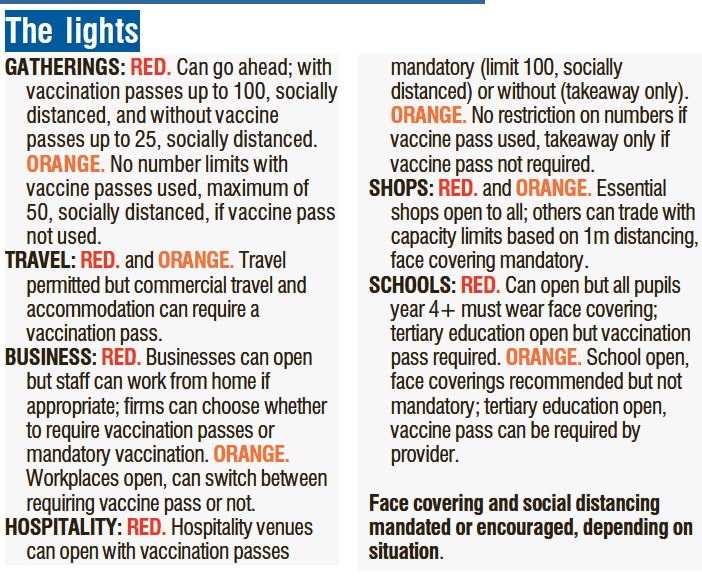New Zealand is poised to be stopped in its tracks by a Red traffic light.
Prime Minister Jacinda Ardern yesterday said the entire country was now at Orange, but would switch to Red within 24-48 hours of the first confirmed community transmission case of Omicron.
That could come sooner rather than later.
Three community cases of Omicron in Auckland have been confirmed and a close contact location of interest announced, and a person with a suspected case has been identified in Palmerston North and 15 locations of interest posted on the Ministry of Health website so far.
Preparations are well under way for Omicron in the South, and on Wednesday night more than 100 primary health workers were briefed on plans to handle cases of the fast-spreading variant of Covid-19.
"We will have to ensure we have capacity for testing in the community and for care of Covid patients recovering in the community," WellSouth chief executive Andrew Swanson-Dobbs said.
"It was a good meeting and clearly practices are ready for what is coming and hopefully we can deal with it once it is here."

While Omicron is regarded as less virulent than the Delta variant, overseas experience is that its extremely rapid rate of transmission creates more cases and higher numbers of people who need hospital-level treatment.
Should large numbers of Omicron cases appear in Otago and Southland it was expected many people would be at home sick, and households needed to have plans in place and medical supplies at hand to manage, Mr Swanson-Dobbs said.
"The southern region is different from parts of Australia. We are very rural and very remote, and therefore we need to work with practices and pharmacies to ensure they have the capacity and capability to handle this Omicron variant.
"Testing throughout the region will be important, but also having support for patients who are positive-Covid in home and access to care is going to be essential."
Modelling presented to the Southern District Health Board in early November, based on a Delta outbreak, painted a bleak worst-case scenario of 880 cases a week in Otago and Southland and 24 cases a week in the most likely scenario, with high vaccination rates and basic public health measures.
Wards have been set aside in Dunedin Hospital for the region’s Covid-19 patients and the SDHB is setting up self-isolation facilities throughout the region.
SDHB acting quality and clinical governance executive director Dr Hywel Lloyd said health professionals remained committed to stamping out Covid-19 should it enter the region, for as long as that was feasible.
"Public Health would embark on a full-throttle public health response to stamp it out," Dr Lloyd said.
"Beyond that, we are thinking about how we can manage cases in the community when we have really rapidly accelerating numbers and what we will need to provide, and how they can reach out if they are not doing so well," Dr Lloyd said.
Based on overseas experience of Omicron, the SDHB was planning for between 25% and 35% of hospital staff being absent due to illness.
"Some areas have reported higher, and that will significantly impact our ability to manage the current levels of care that we can provide, and we are going to have to make adjustments of what we do and what we focus on."
Dunedin Hospital’s dedicated Covid-19 wards are on the seventh floor, a part of the building now partly closed down because of a norovirus outbreak.
"Our infection control staff are doing an amazing job of trying to stamp that out," Dr Lloyd said.
"It reinforces to everybody the importance of really good hand hygiene."
Business South chief executive Mike Collins said businesspeople were worried about how rapidly restrictions in the Red setting could be imposed and about their impact.
Ms Ardern said that the whole country would need to move to Red, and quickly, to try to prevent hospitals and the wider health system from being overwhelmed.
"While we are better placed than most countries to minimise the spread of Omicron, we will have higher case numbers than we are used to or have ever experienced before.
"The Red setting allows businesses to remain open and domestic travel to continue, but includes mask wearing and gathering restrictions to help slow the spread of the virus and keep pressure off our health system."
Ms Ardern said for New Zealand to move from Red back to Orange, there would need to be clear evidence the health system was coping with the virus caseload.
"We know that we will experience in New Zealand cases at a level that we haven’t experienced before."
She said New Zealand had the capacity to carry out and process 40,000 PCR tests a day without any strain on the health system, and that rapid antigen tests would be used more widely.
"Currently we have 4.6million in the country and tens of millions on order."














